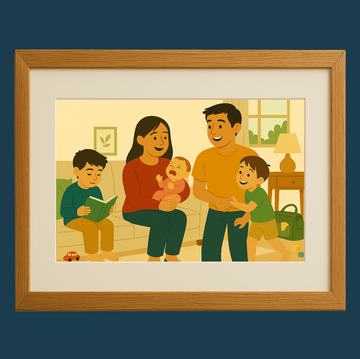Especially when political matters feel raw and lack civility, a parent's initial reflex can be to shield their child from the discourse around the election. But experts say we ought to do otherwise, encouraging an exchange of age-appropriate information and ideas about political institutions, politicians, and policy stances.
In a 2016 survey conducted by the company Care.com, nearly 90% of parents who didn’t discuss politics with their kids said it was because they were too young to understand. But Judith Myers-Walls, Ph.D., a professor emeritus of child development at Purdue University, says the first stage of “they just don’t get it” doesn’t last long: “Children as young as 3 have some understanding,” she says.
Preschoolers may have a vague sense that a political world exists and is split into two groups, since this is right around the age children develop a sense of “us” and “them,” explains Jill S. Greenlee, Ph.D., associate professor of Politics and Women’s, Gender, and Sexuality Studies at Brandeis University. And their intense focus on fairness opens the door to rudimentary discussions of justice, according to Erin Pahlke, Ph.D., an associate professor of psychology at Whitman College.
As they reach school age, children understand concrete political details but abstract concepts still tend to elude them. Around the 2016 election, for example, the issue kids talked about most was immigration, because a border wall is a very tangible thing. But their thinking tends to be black and white, says Meagan Patterson, Ph.D., a professor of educational psychology at the University of Kansas, which — when combined with their information source being snippets of overheard conversations — produces fearful misunderstandings.
“There is a fair amount of individual variability in terms of what kids know,” Dr. Patterson says, with researchers encountering “an 8-year-old who doesn’t know who the presidential candidates are, and an 8-year-old who can explain the electoral college.” And the rate at which a child moves from a limited, stark political understanding to wrapping their head around nuanced, conceptual issues depends on the scaffolding they get from adults.
So no matter what age your child is, you can talk to them about political issues in language they’ll understand. But first, there are ground rules. Experts say to follow these do's and don'ts when talking politics around kids.
Don’t just think about the federal level.
If national issues feel too fraught or removed, state and local debates can provide a good way to talk about how democracy works, Dr. Greenlee says. Both Vote! by Eileen Christelow and Duck for President by Doreen Cronin can help explain the various levels of government.
Differentiate between people and offices.
By fourth grade, Dr. Greenlee’s research shows, children can distinguish between the presidency and the president. (If I Were President by Catherine Stier nails that topic.) As they grow, it’s important to be explicit, telling our kids that even if we don’t like a specific elected official, we can still value the institution and have trust in it. And Greenlee says, “I always remind people — small ones and big ones, alike! — that democracies need at least two healthy parties that compete freely.” So we may find the words coming out of one party’s candidate deplorable, while nonetheless being glad the party exists.
Don’t let your disillusionment dampen their interest or freak them out.
Bring up the idea of checks and balances. “Children should know that adults have got this,” says Dr. Laura Markham, author of Peaceful Parent, Happy Kids. We might be scared, but we shouldn’t let them in on it if we can help it. Say things like, “Our democracy is pretty strong, and it’s set up so that lots of people are involved in making decisions.”
It’s tempting to be melodramatic, Dr. Patterson says, but we should avoid theatrics if we can. “If you’re talking to your spouse about, ‘Oh, if this person wins the election we’re moving to Canada,’ realize that your kid in the next room may think you’re really moving, and they have to leave all their friends behind,” she says. Guidance from the American Psychological Association (APA) says allowing kids to witness the full brunt of your political anxiety or anger can be destabilizing.
Teach them not to believe everything they hear.
Offering reassurance and optimism doesn’t mean creating chumps, though. Children need to know they can’t take everything they hear about politics at face value. Talk about elections in general: Are they popularity contests? Are they about ideas? A little of both? What role do race and gender play? Introduce kids to political cartoons, the role of social media and the impact of polls on campaign momentum.
When you see a political advertisement, ask what the creators are trying to make people think or do. Who paid for it? What emotions are they using to try to get us to do what they want us to do? Tell kids that fear-mongering and heartstring-pulling are both tried-and-true election strategies. That’s not just the case for ads but for candidates’ speeches, too. When kids watch an interview or debate with you, point out when a candidate doesn’t answer the question, circling back to talking points instead. Explain how politicians use scarecrows to distract attention from important issues and dog-whistling to rally their base. (Nick Bruel’s Bad Kitty for President has the best faux negative campaign ad I’ve seen.)
Don't allow them to confuse passion and vitriol.
Bum. Dumb as a rock. Crazy.
It’s important to support the principle of free speech, but “when kids see public discourse that is disrespectful in tone, they learn that we adults are not actually serious when we tell them that they should be kind and respectful,” Dr. Markham says. Just because it’s constitutional or comes from an understandable emotion, doesn’t mean it’s okay. And it’s no more okay for famous people than for us, or for one political party than the other. In her advice column for the Washington Post, Meaghan Leahy recommends finding great politicians and showing kids clips of their communication style to provide an alternative model.
For younger kids, “Talk about good and bad ideas, not good and bad people,” Dr. Greenlee says, making it clear that a difference of opinion doesn’t necessitate demonizing someone. Children also need to be explicitly told, Dr. Myers-Walls says, that in most cases holding a different viewpoint or belonging to a different group doesn’t make you enemies, and that relationships can change over time. (Try pointing to a cross-rivalry friendship in sport, like the one between Larry Bird and Magic Johnson.)
Negative partisanship — where your preference is less about what your own group stands for and more about your distaste for the other group — is something research shows kids can develop early. But they can be taught to avoid it. The very best way to do that, regardless of your child’s age, is modeling. Check your own snide comments and eyerolls. When you encounter name-calling in the political realm, call it out. Say aloud: “Why would anyone think that sign will convince people to reconsider their perspective?”
Lead with questions.
What are other kids saying about the election? What have you heard adults saying? Do you have any questions? What do you think?
These are the sort of open-ended questions experts recommend using to initiate a dialogue. Asking them, Dr. Myers-Walls says, teaches kids that politics isn’t a dirty subject that has to be all tension and eggshells. Start by letting your child guide the conversation, but it’s okay to switch to information-sharing mode once a comfortable back-and-forth has been established.
Don’t shove your views down their throats.
Pretty much all parents want to transmit a value system to their children. For some, the idea of their kid switching from blue to red, or vice versa, is unacceptable. Others seek to encourage political literacy, equipping their child to make considered, rational choices from a place of integrity, regardless of whether they adopt our specific political beliefs. (For example, I can say it’s important to me that my kids value equity, and at the same time accept that they might develop a different opinion on, say, whether caretakers receiving a basic income would be good for society.)
Luckily, experts recommend the same strategies for all of us. When you talk about issues, try to get inside the heads of folks on both sides, and be fair in acknowledging what each perspective has going for it. Support “rigorous debate at school,” both in the classroom and under the auspices of the National Speech and Debate Association, says Michael McDevitt, Ph.D., a professor at the University of Colorado Boulder. Don’t be afraid to explain why you believe what you believe. If kids take a stance that makes you uncomfortable, offer to look up relevant information together.
And if you do want your kids to adopt the same partisan identification, Dr. Greenlee says, know that it’s already pretty likely. Children’s attitudes tend to reflect the voting patterns of not only their parents but also of the counties they live in. It’s even more likely when parents’ views are stable, they agree with one another, and they talk about politics frequently at home. If that first part doesn’t describe your situation, remember that the “talk about it” bit still applies: “A silent home is worse than a house divided,” McDevitt says.
Provide specific language for tough situations they'll encounter with their friends.
Whether hard conversations are happening on the playground or in school, it’s important to empower your kids to handle them. At school, Dr. Markham suggests using: "It's okay for people to have different opinions about things. You're my friend and that's what matters most to me." Another tack: “I wonder what our parents would say about this? Do you think they could help us find the facts together?" Guidance from the APA says if all else fails, we should make sure children know they can walk away from uncomfortable situations.
Don't make kids wait for 18 to participate democratically.
Very young kids can begin learning about the democratic process in the home. If it’s all the same to you, why not let them vote on where the family eats out, or what to watch for family movie night?
Dr. Myers-Walls says kids “often get pretty passionate about causes and want to make a difference for things around them.” Remind them that they aren’t powerless. Most schools have some sort of student council kids can get involved in, like Grace does in Grace for President. Books such as Follow the Moon Home tell stories of successful youth activism. And kids can always encourage adults to vote (they do just that in Vote! and Vote for Our Future!).
By imparting knowledge about the way government and voting work, as well as the ability to think critically and discuss what kids see and hear, parents can take steps toward what most of us want: to produce a citizen capable of fully exercising their democratic rights.
Books to Spark Political Interest
In addition to our favorites above, check out these for further reading:
- Vote! by Eileen Christelo
- Leo’s First Vote by Christina Soontornva
- When You Grow Up To Vote by Eleanor Roosevelt
- The Next President by Kate Messner
- Vote for Our Future! by Margaret McNamara
- If I Were President by Catherine Stier
- Grace Goes to Washington by Kelly S. DiPucchio
- Bad Kitty for President by Nick Bruel
- A Kids Book About Voting by Next Up
- What Can a Citizen Do? by Dave Eggers
- One Vote, Two Votes, I Vote, You Vote by Bonnie Worth
- What's the Big Deal About Elections by Ruby Shamir
- Sofia Valdez, Future Prez by Andrea Beaty
- Lillian's Right to Vote by Jonah Winter
- Follow the Moon Home by Philippe Cousteau and Deborah Hopkinson
For graphic novels, School Library Journal recommends eight titles (in addition to more picture books) that bring the principles of government and politics to life.

Gail Cornwall is a former public school teacher and recovering lawyer who now works as a stay-at-home mom and writes about parenthood. Born in St. Louis and raised in the Bay Area, she’s a serial monogamist of urban living who resided in Berkeley, New York, DC, Boston, and Seattle before committing to San Francisco. You can find Gail on Facebook and Twitter, or read more at gailcornwall.com.

















